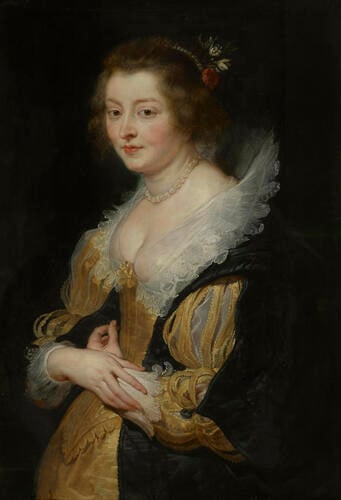-
1 of 253523 objects
Portrait of a Woman c.1625-30
Oil on panel | 86.8 x 59.3 cm (support, canvas/panel/stretcher external) | RCIN 400118

Sir Peter Paul Rubens (Siegen 1577 - Antwerp 1640)
Portrait of a Woman c.1625-30
-
The Lunden and Rubens families were connected by marriage; in 1622 Arnold Lunden married Susanna Fourment (1599-1643); in 1630 Rubens married her younger sister, Helena Fourment (b.1614). In 1660 Arnold's nephew, Jean-Baptiste Lunden, married Rubens’s granddaughter, Hélène-Françoise Rubens. The Lunden family collection was much admired in Brussels during the eighteenth century and included paintings, like The Farm at Laken (Royal Collection, RCIN 405333), which would seem to have come from Rubens’s own collection.
This Portrait of a Woman may be the ‘picture of a woman with her hands one uppon another’ listed in Rubens’s house at his death. When the Lunden collection became available in the early nineteenth century, George IV bought this painting (along with The Farm at Laken), as a portrait of Rubens’s wife, Helena Fourment. The Chapeau de Paille (National Gallery, London) was also offered to him and is the only work he is ever known to have refused on grounds of cost. Both these portraits (Portrait of a Woman and the Chapeau de Paille) have an informal and engaging charm entirely consistent with their claim to be portraits of Rubens’s own extended family. In neither case is there much evidence for a more precise identification; the Royal Collection portrait does not seem to depict Helena, whose features are well recorded in other images, but the name of another Fourment sister, Elizabeth (born 1606), has been suggested.
On the back of this panel is a summary oil sketch by Rubens for an allegorical subject, a warrior seizing Opportunity (Occasio) by her forelock, which can be connected with a (now lost) painting of the 1630s. Unlike most of Rubens’s oil sketches, which can be (and were) enjoyed as completed paintings, this is a nearly illegible ‘work-in-progress’. It appears from the technical evidence that Rubens used the back of his portrait for the oil sketch rather than vice versa - another reason to suppose that this portrait remained in his studio. The fact that Rubens made temporary use of a spare panel surface does not mean however that this beautiful portrait was ever despised or discarded.
Catalogue entry adapted from Bruegel to Rubens: Masters of Flemish Painting, London, 2007Provenance
Purchased from L.J. Nieuwenhuys via John Smith on 8 December 1818
-
Creator(s)
(nationality)Acquirer(s)
-
Medium and techniques
Oil on panel
Measurements
86.8 x 59.3 cm (support, canvas/panel/stretcher external)
Category
Object type(s)
Other number(s)
Alternative title(s)
Helena Fourment (b.1614), previously identified as
Isabella Brandt (1591-1626), previously identified as
Verso sketch previously identified as the Continence of Scipio